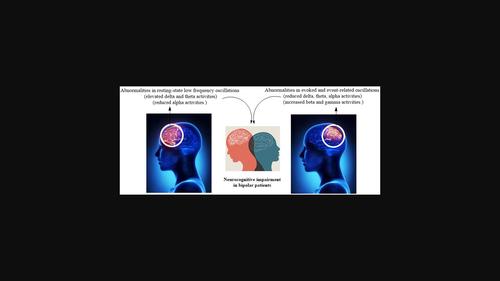Our official English website, www.x-mol.net, welcomes your feedback! (Note: you will need to create a separate account there.)
Association between abnormal brain oscillations and cognitive performance in patients with bipolar disorder: Molecular mechanisms and clinical evidence
SYNAPSE ( IF 2.3 ) Pub Date : 2022-07-18 , DOI: 10.1002/syn.22247 Zhou Lu 1 , Huixiao Wang 1 , Jiajie Gu 1 , Feng Gao 1
SYNAPSE ( IF 2.3 ) Pub Date : 2022-07-18 , DOI: 10.1002/syn.22247 Zhou Lu 1 , Huixiao Wang 1 , Jiajie Gu 1 , Feng Gao 1
Affiliation

|
Brain oscillations have gained great attention in neuroscience during recent decades as functional building blocks of cognitive-sensory processes. Research has shown that oscillations in “alpha,” “beta,” “gamma,” “delta,” and “theta” frequency windows are highly modified in brain pathology, including in patients with cognitive impairment like bipolar disorder (BD). The study of changes in brain oscillations can provide fundamental knowledge for exploring neurophysiological biomarkers in cognitive impairment. The present article reviews findings from the role and molecular basis of abnormal neural oscillation and synchronization in the symptoms of patients with BD. An overview of the results clearly demonstrates that, in cognitive-sensory processes, resting and evoked/event-related electroencephalogram (EEG) spectra in the delta, theta, alpha, beta, and gamma bands are abnormally changed in patients with BD showing psychotic features. Abnormal oscillations have been found to be associated with several neural dysfunctions and abnormalities contributing to BD, including abnormal GABAergic neurotransmission signaling, hippocampal cell discharge, abnormal hippocampal neurogenesis, impaired cadherin and synaptic contact-based cell adhesion processes, extended lateral ventricles, decreased prefrontal cortical gray matter, and decreased hippocampal volume. Mechanistically, impairment in calcium voltage-gated channel subunit alpha1 I, neurotrophic tyrosine receptor kinase proteins, genes involved in brain neurogenesis and synaptogenesis like WNT3 and ACTG2, genes involved in the cell adhesion process like CDH12 and DISC1, and gamma-aminobutyric acid (GABA) signaling have been reported as the main molecular contributors to the abnormalities in resting-state low-frequency oscillations in BD patients. Findings also showed the association of impaired synaptic connections and disrupted membrane potential with abnormal beta/gamma oscillatory activity in patients with BD. Of note, the synaptic GABA neurotransmitter has been found to be a fundamental requirement for the occurrence of long-distance synchronous gamma oscillations necessary for coordinating the activity of neural networks between various brain regions.
中文翻译:

双相情感障碍患者异常脑振荡与认知能力之间的关联:分子机制和临床证据
近几十年来,作为认知感觉过程的功能构建块,脑振荡在神经科学中获得了极大的关注。研究表明,“alpha”、“beta”、“gamma”、“delta”和“theta”频率窗口的振荡在脑病理学中被高度修改,包括在双相情感障碍 (BD) 等认知障碍患者中。对大脑振荡变化的研究可以为探索认知障碍中的神经生理生物标志物提供基础知识。本文回顾了异常神经振荡和同步在 BD 患者症状中的作用和分子基础的研究结果。结果概述清楚地表明,在认知感觉过程中,δ、θ、α、β、BD 患者表现出精神病特征,γ 谱带异常变化。已发现异常振荡与导致 BD 的几种神经功能障碍和异常有关,包括异常 GABA 能神经传递信号、海马细胞放电、异常海马神经发生、受损的钙粘蛋白和基于突触接触的细胞粘附过程、侧脑室扩展、前额叶皮质减少灰质和海马体积减少。机制上,钙电压门控通道亚基 alpha1 I、神经营养酪氨酸受体激酶蛋白、参与脑神经发生和突触发生的基因(如 WNT3 和 ACTG2)、参与细胞粘附过程的基因(如 CDH12 和 DISC1)受损,据报道,和 γ-氨基丁酸 (GABA) 信号传导是 BD 患者静息态低频振荡异常的主要分子因素。研究结果还表明,BD 患者的突触连接受损和膜电位中断与异常的 β/γ 振荡活动有关。值得注意的是,已发现突触 GABA 神经递质是发生长距离同步伽马振荡的基本要求,这是协调不同大脑区域之间神经网络活动所必需的。研究结果还表明,BD 患者的突触连接受损和膜电位中断与异常的 β/γ 振荡活动有关。值得注意的是,已发现突触 GABA 神经递质是发生长距离同步伽马振荡的基本要求,这是协调不同大脑区域之间神经网络活动所必需的。研究结果还表明,BD 患者的突触连接受损和膜电位中断与异常的 β/γ 振荡活动有关。值得注意的是,已发现突触 GABA 神经递质是发生长距离同步伽马振荡的基本要求,这是协调不同大脑区域之间神经网络活动所必需的。
更新日期:2022-07-18
中文翻译:

双相情感障碍患者异常脑振荡与认知能力之间的关联:分子机制和临床证据
近几十年来,作为认知感觉过程的功能构建块,脑振荡在神经科学中获得了极大的关注。研究表明,“alpha”、“beta”、“gamma”、“delta”和“theta”频率窗口的振荡在脑病理学中被高度修改,包括在双相情感障碍 (BD) 等认知障碍患者中。对大脑振荡变化的研究可以为探索认知障碍中的神经生理生物标志物提供基础知识。本文回顾了异常神经振荡和同步在 BD 患者症状中的作用和分子基础的研究结果。结果概述清楚地表明,在认知感觉过程中,δ、θ、α、β、BD 患者表现出精神病特征,γ 谱带异常变化。已发现异常振荡与导致 BD 的几种神经功能障碍和异常有关,包括异常 GABA 能神经传递信号、海马细胞放电、异常海马神经发生、受损的钙粘蛋白和基于突触接触的细胞粘附过程、侧脑室扩展、前额叶皮质减少灰质和海马体积减少。机制上,钙电压门控通道亚基 alpha1 I、神经营养酪氨酸受体激酶蛋白、参与脑神经发生和突触发生的基因(如 WNT3 和 ACTG2)、参与细胞粘附过程的基因(如 CDH12 和 DISC1)受损,据报道,和 γ-氨基丁酸 (GABA) 信号传导是 BD 患者静息态低频振荡异常的主要分子因素。研究结果还表明,BD 患者的突触连接受损和膜电位中断与异常的 β/γ 振荡活动有关。值得注意的是,已发现突触 GABA 神经递质是发生长距离同步伽马振荡的基本要求,这是协调不同大脑区域之间神经网络活动所必需的。研究结果还表明,BD 患者的突触连接受损和膜电位中断与异常的 β/γ 振荡活动有关。值得注意的是,已发现突触 GABA 神经递质是发生长距离同步伽马振荡的基本要求,这是协调不同大脑区域之间神经网络活动所必需的。研究结果还表明,BD 患者的突触连接受损和膜电位中断与异常的 β/γ 振荡活动有关。值得注意的是,已发现突触 GABA 神经递质是发生长距离同步伽马振荡的基本要求,这是协调不同大脑区域之间神经网络活动所必需的。



























 京公网安备 11010802027423号
京公网安备 11010802027423号